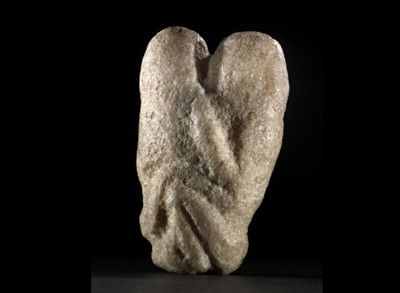But what do we know of the people captured in this lovers' embrace? Well, the maker or should we say the sculptor? of the lovers, belonged to a people that we now call the Natufians, who lived in a region that straddled what is today Israel, Palestine, Lebanon and Syria, and our sculpture came from the area south-east of Jerusalem. In 1933 the great French archaeologist Abbé Henri Breuil and a French diplomat, René Neuville, visited a small museum in Bethlehem. Neuville wrote:
但我們還可以知道關(guān)于這對擁抱中戀人的什么東西呢?這件戀人作品的工匠,也許我們應(yīng)該稱之為雕塑家,來自于我們今天稱之為Natufian人,大概定居在現(xiàn)今以色列、巴勒斯坦,黎巴嫩及敘利亞那個地域上,而我們這位雕塑家來自于取路撒冷東南部的某處。1933年杰出的法國考古學(xué)家兼神甫亞布·享利·布勒伊與一名法國外交官諾伊維爾參觀在伯利恒地區(qū)的一座小型博物館。諾伊維爾記錄道:
'Towards the end of our visit, I was shown a wooden casket containing various items from the surrounding areas, of which none, apart from this statuette, was of any value. I realised immediately the particular significance of the design involved and asked the source of these objects. I was told that they had been brought by a Bedouin who was returning from Bethlehem towards the Dead Sea.'
“隨著我們行程接近尾聲,有人向我展示了一個長木盒,裝有附近地區(qū)收集來的形形色色的物品,但除了這件雕像,其他都是一些毫無價值的物什。我立即意識到這件物品的特殊重要性,并詢間它的出處。人家告訴我這盒物什是一個途徑死海,從伯利恒回來的貝都因人帶來的。”
Intrigued by the figure, Neuville wanted to know more about its discovery and he sought out the Bedouin he'd been told about. He managed to track down the man responsible for the find, who took him to the very cave - in the Judean desert not far from Bethlehem - in which the sculpture of the lovers had been discovered. The cave was called Ain Sakhri, and so these sculpted lovers that had so captivated Neuville are still known as the Ain Sakhri lovers.
對著物品濃厚的興趣,驅(qū)使諾伊維爾去了解更多關(guān)于它的發(fā)現(xiàn)過程,于是他開始去打探人們所說的那位貝都因人的下落。最后他設(shè)法找到了最初發(fā)現(xiàn)這戀人雕塑的那個人。那人把他帶到了當初雕塑出土的那個洞穴,位于伯利恒不遠的朱迪亞沙漠。那個洞穴被稱之為Ain Sakhri,所以那對讓諾伊維爾著迷不已的擁抱中的戀人也便稱之為Ain Sakhri戀人了。
Crucially, the sculpture had been found with objects which made it clear that the cave had been a dwelling rather than a grave, and so our sculpture must have played some kind of role in domestic everyday life.
更重要的是,出土這對戀人雕像的同一洞穴里還發(fā)現(xiàn)了其他的物品,明確顯示了這洞穴曾經(jīng)是處日常居住場所,而不是一處墓葬。因此我們這件雕像作品在當時人們的日常生活中肯定起到某種作用。
We don't know exactly what that role might have been, but we do know that this dwelling belonged to people who were living at the dawn of agriculture. Their new way of life involved the collecting and storing of food.
我們不知道它究竟曾經(jīng)充當了什么實際角色,但我們知道這洞穴的主人生活的時代正值農(nóng)業(yè)的曙光。他們嶄新的生活方式包括了懼與儲存食物。
Wild grass seeds fall off the plant and are spread easily by the wind or eaten by the birds, but these people selected seeds which stayed on the stalk , a very important characteristic if a grass is ever going to be worth cultivating. They stripped these seeds, removed the husks and ground the grains to flour. Later, they would go on to sow the surplus seeds. Farming had begun and ever since, together we've been breaking bread.
野草種子通常從植物上脫落一來,然后輕易地通過風力傳播,或者被鳥類吃掉,但是這些人類偏偏選擇那些保留在谷物稈上的種子,這是決定某種農(nóng)作物是否值得培育的重要一點。人類把這些種子采集、剝殼,然后把谷物碾磨成面粉。再后來,他們開始學(xué)會了把剩余的種子拿去播種。農(nóng)業(yè)誕生了——并從那刻起,直到今天,我們?nèi)匀辉诤婵久姘?/p>












